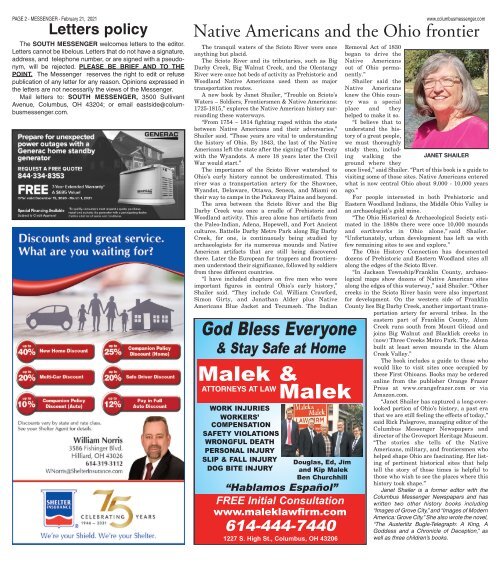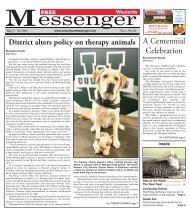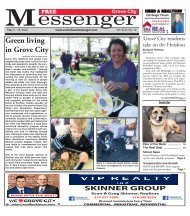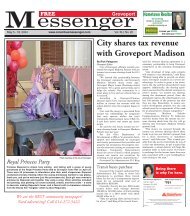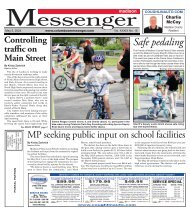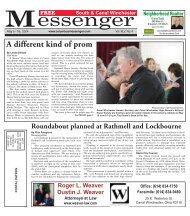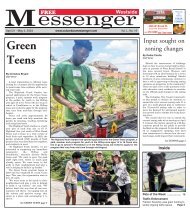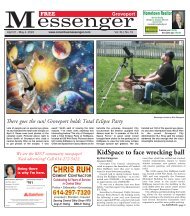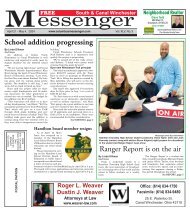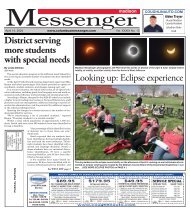You also want an ePaper? Increase the reach of your titles
YUMPU automatically turns print PDFs into web optimized ePapers that Google loves.
PAGE 2 - MESSENGER - <strong>February</strong> 21, <strong>2021</strong><br />
Letters policy<br />
The SOUTH MESSENGER welcomes letters to the editor.<br />
Letters cannot be libelous. Letters that do not have a signature,<br />
address, and telephone number, or are signed with a pseudonym,<br />
will be rejected. PLEASE BE BRIEF AND TO THE<br />
POINT. The <strong>Messenger</strong> reserves the right to edit or refuse<br />
publication of any letter for any reason. Opinions expressed in<br />
the letters are not necessarily the views of the <strong>Messenger</strong>.<br />
Mail letters to: SOUTH MESSENGER, 3500 Sullivant<br />
Avenue, Columbus, OH 43204; or email eastside@columbusmessenger.com.<br />
www.columbusmessenger.com<br />
Native Americans and the Ohio frontier<br />
The tranquil waters of the Scioto River were once<br />
anything but placid.<br />
The Scioto River and its tributaries, such as Big<br />
Darby Creek, Big Walnut Creek, and the Olentangy<br />
River were once hot beds of activity as Prehistoric and<br />
Woodland Native Americans used them as major<br />
transportation routes.<br />
A new book by Janet Shailer, “Trouble on Scioto’s<br />
Waters — Soldiers, Frontiersmen & Native Americans:<br />
1725-1815,” explores the Native American history surrounding<br />
these waterways.<br />
“From 1754 — 1814 fighting raged within the state<br />
between Native Americans and their adversaries,”<br />
Shailer said. “Those years are vital to understanding<br />
the history of Ohio. By 1843, the last of the Native<br />
Americans left the state after the signing of the Treaty<br />
with the Wyandots. A mere 18 years later the Civil<br />
War would start.”<br />
The importance of the Scioto River watershed to<br />
Ohio’s early history cannot be underestimated. This<br />
river was a transportation artery for the Shawnee,<br />
Wyandot, Delaware, Ottawa, Seneca, and Miami on<br />
their way to camps in the Pickaway Plains and beyond.<br />
The area between the Scioto River and the Big<br />
Darby Creek was once a cradle of Prehistoric and<br />
Woodland activity. This area alone has artifacts from<br />
the Paleo-Indian, Adena, Hopewell, and Fort Ancient<br />
cultures. Battelle Darby Metro Park along Big Darby<br />
Creek, for one, is continuously being studied by<br />
archaeologists for its numerous mounds and Native<br />
American artifacts that are still being discovered<br />
there. Later the European fur trappers and frontiersmen<br />
understood their significance, followed by soldiers<br />
from three different countries.<br />
“I have included chapters on five men who were<br />
important figures in central Ohio’s early history,”<br />
Shailer said. “They include Col. William Crawford,<br />
Simon Girty, and Jonathan Alder plus Native<br />
Americans Blue Jacket and Tecumseh. The Indian<br />
God Bless Everyone<br />
& Stay Safe at Home<br />
Malek &<br />
ATTORNEYS AT LAW<br />
Malek<br />
WORK INJURIES<br />
WORKERS’<br />
COMPENSATION<br />
SAFETY VIOLATIONS<br />
WRONGFUL DEATH<br />
PERSONAL INJURY<br />
SLIP & FALL INJURY<br />
DOG BITE INJURY<br />
Douglas, Ed, Jim<br />
and Kip Malek<br />
Ben Churchhill<br />
“Hablamos Español”<br />
FREE Initial Consultation<br />
www.maleklawfirm.com<br />
614-444-7440<br />
1227 S. High St., Columbus, OH 43206<br />
Removal Act of 1830<br />
began to drive the<br />
Native Americans<br />
out of Ohio permanently.”<br />
Shailer said the<br />
Native Americans<br />
knew the Ohio country<br />
was a special<br />
place and they<br />
helped to make it so.<br />
“I believe that to<br />
understand the history<br />
of a great people,<br />
we must thoroughly<br />
study them, including<br />
walking the<br />
ground where they<br />
JANET SHAILER<br />
once lived,” said Shailer. “Part of this book is a guide to<br />
visiting some of those sites. Native Americans entered<br />
what is now central Ohio about 9,000 - 10,000 years<br />
ago.”<br />
For people interested in both Prehistoric and<br />
Eastern Woodland Indians, the Middle Ohio Valley is<br />
an archaeologist’s gold mine.<br />
“The Ohio Historical & Archaeological Society estimated<br />
in the 1880s there were once 10,000 mounds<br />
and earthworks in Ohio alone,” said Shailer.<br />
“Unfortunately, urban development has left us with<br />
few remaining sites to see and explore.”<br />
The Ohio History Connection has documented<br />
dozens of Prehistoric and Eastern Woodland sites all<br />
along the edges of the Scioto River.<br />
“In Jackson Township/Franklin County, archaeological<br />
maps show dozens of Native American sites<br />
along the edges of this waterway,” said Shailer. “Other<br />
creeks in the Scioto River basin were also important<br />
for development. On the western side of Franklin<br />
County lies Big Darby Creek, another important transportation<br />
artery for several tribes. In the<br />
eastern part of Franklin County, Alum<br />
Creek runs south from Mount Gilead and<br />
joins Big Walnut and Blacklick creeks in<br />
(now) Three Creeks Metro Park. The Adena<br />
built at least seven mounds in the Alum<br />
Creek Valley.”<br />
The book includes a guide to those who<br />
would like to visit sites once occupied by<br />
these First Ohioans. Books may be ordered<br />
online from the publisher Orange Frazer<br />
Press at www.orangefrazer.com or via<br />
Amazon.com.<br />
“Janet Shailer has captured a long-overlooked<br />
portion of Ohio’s history, a past era<br />
that we are still feeling the effects of today,”<br />
said Rick Palsgrove, managing editor of the<br />
Columbus <strong>Messenger</strong> Newspapers and<br />
director of the Groveport Heritage Museum.<br />
“The stories she tells of the Native<br />
Americans, military, and frontiersmen who<br />
helped shape Ohio are fascinating. Her listing<br />
of pertinent historical sites that help<br />
tell the story of those times is helpful to<br />
those who wish to see the places where this<br />
history took shape.”<br />
Janet Shailer is a former editor with the<br />
Columbus <strong>Messenger</strong> Newspapers and has<br />
written two other history books including<br />
“Images of Grove City,” and “Images of Modern<br />
America: Grove City.” She also wrote the novel,<br />
“The Austerlitz Bugle-Telegraph: A King, A<br />
Goddess and a Chronicle of Deception,” as<br />
well as three children’s books.


